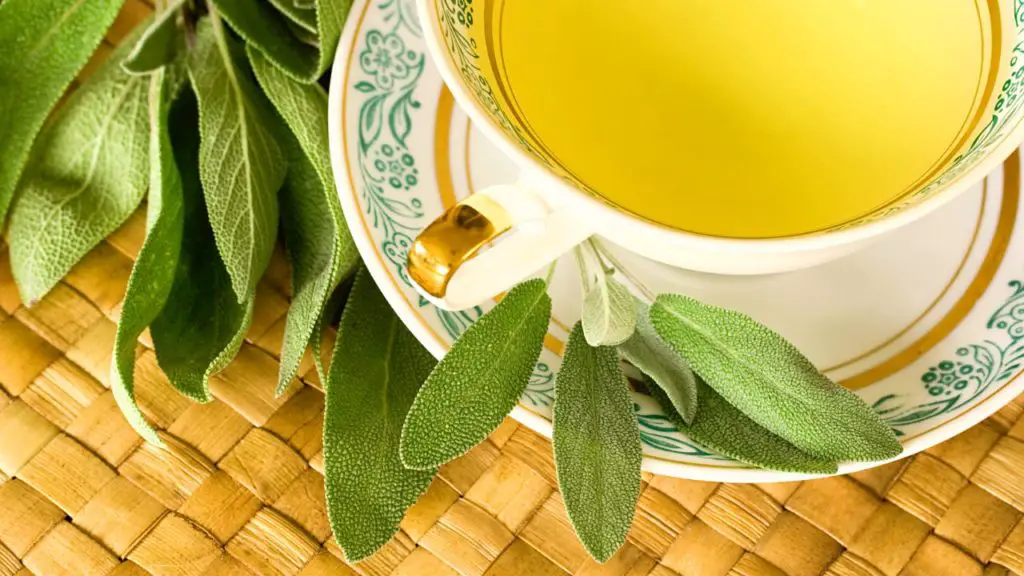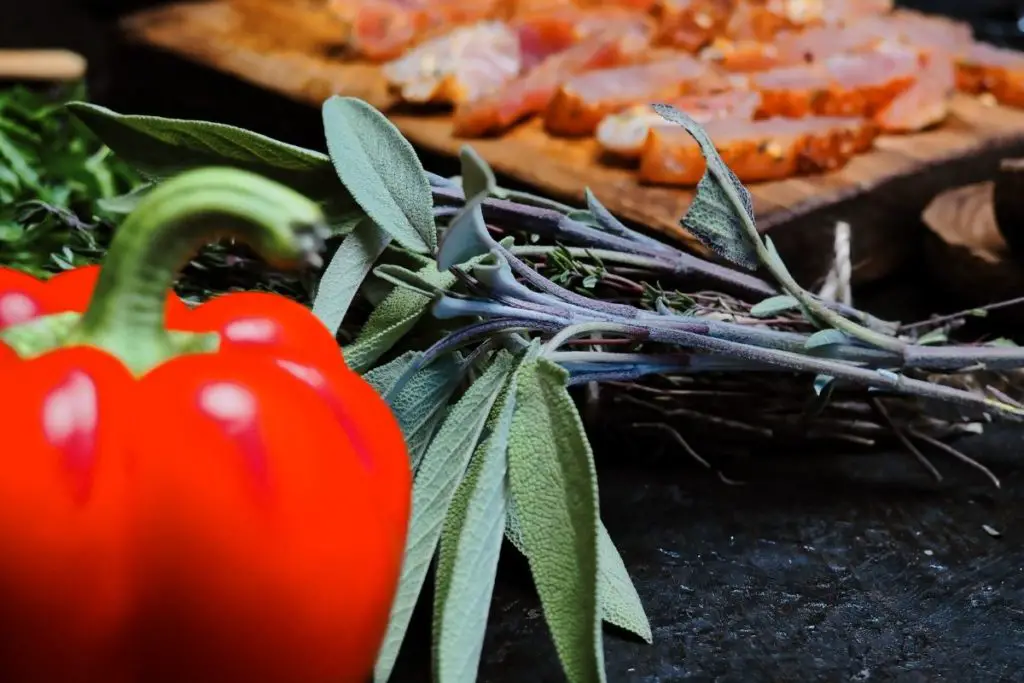Sage (Salvia officinalis) is a popular herb that comes with a strong aroma and pronounced herbal flavor. Humans have been using this fragrant herb since ancient times for medicinal purposes. But now it’s most commonly used in a range of savory and sweet recipes.
In this article, I’ll discuss how to use sage in cooking to take advantage of its rich taste, aroma and nutritional profile.
How To Use Sage In Cooking?

This herb works well in heavier dishes with rich ingredients. You can use sage in both fresh and dried forms in a range of different ways while cooking. If you want to enjoy its intense aroma, you should add it to your recipe at the end of the cooking process.
However, fresh sage can retain its flavor better during the cooking process. So, you can also add it at the beginning.
What Does Sage Taste Like?

Sage belongs to the mint family and offers an earthly taste. It feels like a mixture of pine and citrus. It becomes a bit bitter in dried form as its taste becomes concentrated. There are different forms of sage available in the market including culinary, garden, and common sage.
10 Best Ways To Use Sage In Recipes

Usually, sage is used in cooking with other herbs and ingredients such as thyme, rosemary, garlic, parsley, oregano, bay leaf, and onion. Not only does it add its own unique flavor to recipes but it also complements the taste of other ingredients.
The following are some of the best ways to use sage in cooking and your recipes.
1. Use For Garnishing
You can fry fresh sage leaves in order to make a delicious and crisp garnish. The frying process also minimizes the slightly bitter flavor of this pungent herb but its aroma remains the same. You can use fried sage leaves to garnish roasted vegetables, soups, fried potatoes, and pasta dishes.
The best way to fry sage leaves is to drizzle some olive oil or clarified butter on a pan and then add sage leaves to the pan when the oil is heated. Fry them for 30 seconds to one minute on medium heat. You can eat these fried sage leaves as a healthy snack as well.
2. Make Sage Infused Oils And Tinctures
You can infuse fresh sage leaves in a range of liquids such as honey, vinegar, and olive oil. You can easily store them for a long period of time and use these infused liquids in different recipes to enjoy a better taste. For example, you can use sage-infused olive oil to make pasta and salads, or add it to flavor roast turkey or chicken, add it to sauces, or just drizzle a little bit on fresh, homemade crusty bread.
You’ll need to add 10-20 fresh sage leaves to a 500ml or 20oz bottle or jar and fill it with the oil or other liquid. Then place the jar in a dark, cool, and dry spot for about 1-2 weeks. Make sure that you use an airtight jar or bottle and chop or bruise the sage leaves before using.
3. Create Sage Butter
Adding sage to your butter is a great way to enjoy the rich taste in different recipes. All you need to do is to place one stick of room temperature butter in a mixing bowl or food processor, add 2-3 tablespoons of powdered, rubbed, or finely chopped sage to the butter, and mix till well combined. Using parchment paper or aluminum foil, roll it into a tube and place it in the fridge, and use it as needed.
You can also add other ingredients such as minced garlic, sea salt, white pepper, and lemon zest to the mixture if you want. It’ll create a tasty compound butter that will make your recipes more flavorful.
4. Use Sage While Barbecuing
It’s a rather unique use of sage that will help you capitalize on its aroma alone. You’ll need to soak a few sage leaves in olive oil or even in water. After that, throw soaked leaves into hot coals while barbecuing or grilling.
The smoke will add a burnt sage aroma to your grilled meat and gives a beautiful earthy and herbaceous scent. Other than improving taste, this technique will also keep the bugs and insects at bay.
5. Make Seasonings
You can use chopped or dried sage to make seasonings for different recipes. The simplest seasoning recipe involves just salt and sage. You’ll need to mix one cup of salt with four teaspoons of sage using a spice grinder.
Then you can place the mixture in an airtight jar or container for up to one year. This simple recipe will allow you to season soups, vegetables, and meat recipes.
6. Make Sage Marinade
In order to make your meat tastier, consider marinating it with chopped or rubbed sage. You can simply take some crushed or finely chopped sage, mix it with some olive oil, salt, and pepper and rub it on your meat about an hour before cooking, or for a stronger taste, you can leave it in the fridge overnight.
7. Make Candied Sage Leaves
If you like baking, you should definitely make candied sage leaves to garnish your pastry. You can also use finely diced sage leaves to make different cakes, pies, cookies, and homemade rye bread.
To make candied sage leaves, beat 1/2 teaspoon of water with one egg white in a mixing bowl. Dip sage leaves in the mixture and sprinkle superfine sugar to cover them completely. After that, place coated leaves in a dark, dry, and cool spot to dry for 2 to 3 hours.
8. Add Sage To Recipes Directly
You can add dried or fresh sage in different sweet or savory recipes directly. You can pair it with other herbs and spices to make recipes such as stuffing and roast spatchcock turkey.. It can also enhance the flavors of soups, cream sauces, meat, gravy, and baked dishes.
You’ll need to remove leaves from stems if you want to cook with fresh sage. Then you’ll need to rinse the leaves with water properly before using. Use it as a whole leaf or finely chopped.
9. Make Sage Tea
Adding fresh sage leaves to hot boiling water will make great herbal tea. It’s a tasty, healthy cozy, minty, slightly bitter, and pine-flavored drink that offers a lot of benefits. Not only is it stomach- and throat-soothing but it is even claimed to improve your brain health.
You only need to boil a cup of water and place a couple of fresh sage leaves in it. Let it steep for three to five minutes and drink. You can also add a teaspoon of honey or lemon juice to your sage tea to elevate its flavor.
If you steep the leaves too your tea could get too bitter.
It is recommended to drink 3 to 6 cups of sage tea per day.
10. Use In Cocktails
You can use fresh sage leaves in a range of cocktails because of their unique earthy flavor. Generally, sage pairs well with acidic and sweet flavors. It means you can use it in drinks that use orange, lime, lemon, apple, and pineapple. However, I recommend you experiment with different cocktails to find what works best for you.
FAQs

How Do You Store Sage?
You can store fresh sage leaves in a refrigerator and they’ll stay fresh for seven to 10 days. After that, they’ll go stale and their flavor will diminish. If you have dried sage, you can use an airtight container for storing to keep it fresh for up to a year. Make sure that you place the container in a dry, dark, and cool spot.
Here Are 3 Easy Ways To Dry Herbs Without A Dehydrator, (No Flavor Loss).
Where Do You Buy Sage?
You can easily find sage from any grocery store’s spice aisle in dried or rubbed form. But you’ll need to go to a local farmer’s market to buy fresh sage. Make sure that you buy fresh sage with firm and bright-colored leaves.
What Does Sage Taste Good With?
Sage is often used together with other herbs such as marjoram, rosemary, and thyme, and it pairs well with garlic, bay leaf, onion, parsley, and oregano. Therefore saga tastes good in dishes like cured meats, beef stews, sausage, winter squash recipes, stuffing, poultry, and creamy pasta dishes.
Read Also: 9 Best Seasonings To Put In Beef Stew (Rich And Balanced Flavors).
Final Words
Sage is a healthy and versatile herb that you can use in various cooking and baking recipes. Not only does it make your recipes more delicious and unique but it also offers many health benefits. I hope these ideas of cooking with sage will help you make delicious recipes to impress your family and friends.
